
Original Link: https://www.anandtech.com/show/2293
Zippy Gaming G1 (GSM-6600P): Hybrid or Fence-Sitter?
by Christoph Katzer on August 3, 2007 2:30 AM EST- Posted in
- Cases/Cooling/PSUs
Intro
Zippy is a name that is probably not too familiar to most of our readers, since their gaming series was the first step into the retail market not long ago. However, Zippy is actually not a newcomer to the PSU business, as they have been in that market for over 20 years. Up until now, Zippy has specialized in server and redundant power supplies and has become an established name in that segment. When it comes to reliability in the server market, Zippy is one of the names at the top of many lists.
Producing that type of power supply requires a lot of research and background work, which is a good starting point for entering the retail market. In the server market reliability is probably the most important requirement, and that's where Zippy has built their reputation. Today, we're looking at the Gaming-series G1 with 600W. We have also received several more product samples from Zippy and will review them in upcoming weeks. All Zippy power supplies are made in Taiwan which gives the company a better control over the production and quality control; it may not make them inexpensive, but there are times when it's best not to cut corners.

The GSM-6600P (G1) comes with a single 12V rail as we have seen on many power supplies in recent months. This is against the regulation of the actual Power Supply Design Guide, but the guidelines are often disregarded by many manufacturers. The reason it's being ignored is that some manufacturers feel having a single 12V rail that support a higher load helps them to create a more stable PSU that can avoid situations that might lead to a blue-screen/crash/restart when one of the rails gets overloaded, i.e. by a graphics card that requires too much power. This is a somewhat dubious claim, and we will make sure to dig a little deeper into this matter.

Package and Appearance

The retail box seems to be a little too small since the two knobs on the back of the PSU make contact with the wall of the box. We're a bit concerned with the packaging and hope that the lack of protection doesn't result in any damage during shipping. Our unit arrived without incident, but we think a quality power supply should be shipped with a bit more protection.

Along with the power supply Zippy includes a small manual, screws, and a power cord in the box. The PSU itself has a black anodized brushed aluminum housing. The fan is located on the back of the PSU with a punched out fan grille in front of it. One of the unusual additions for the retail market is the little hook Zippy includes near the AC jack. This will secure the power cord against accidental removal during operation.


A small green light under the main switch indicates the health status of the PSU. The front of the unit has large openings punched in it that serve as the air intake from the PC. The two heatsinks are located directly behind the ventilation slots.
Cables and Connectors

All the cables are sleeved with a black mesh to the first connector; after the first connector the wires are exposed, which isn't a huge problem since the cables are often help in place with cable ties. However, for those that value aesthetics, this may not be an ideal solution.
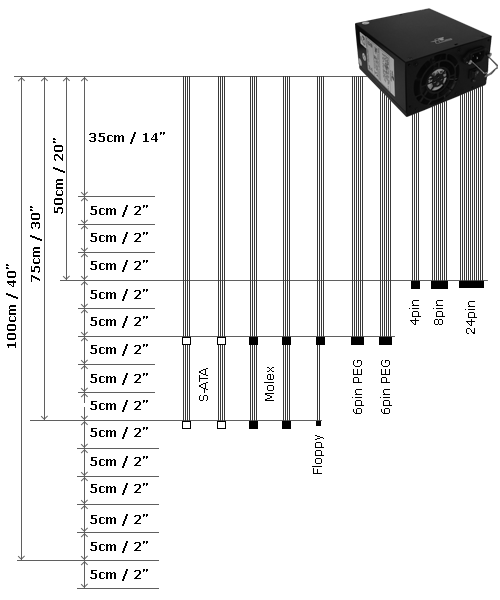
With lengths of up to 75cm the cables are long enough for most of the cases. For a "gaming" PSU we would have appreciated more PEG connectors. Two PEG connections are sufficient for most configurations, but both are 6-pin and it would have been good to get at least one 8-pin PEG connection. Higher-end setups could potentially use up to four PEG connectors, and since this power supply is capable of driving such a setup it's unfortunate that the necessary cables are not present.
The Hook

The hook for the power cord was a great idea and is implemented in all of Zippy's retail products. You just plug the cord in and slide the hook over it. Afterwards, it would require quite a bit of force to remove the cord, so accidental disconnects will hopefully be eliminated.


The hook is designed to work with the included power cord from Zippy since it has the correct shape. As seen in the second picture, it does not work with some other cords, so if you like the feature you will want to make sure you use the correct cable.
Primary Side



The inside looks like your typical PSU. Zippy has all of the components of the transient filter stage located in the upper section of the PCB. It looks very crowded and the fan is located directly behind it. The filter stage however looks very good and includes all the expected components.


On the side we see a small Hitachi cap with 330µF and 400V which is rated up to 105°C. The PFC IC is located on the left side of the primary stage.
Secondary Side


The secondary side has another PCB that contains the circuitry for PWM and fan control. The whole area is quite packed and includes a cable-jungle so there is little chance for any airflow to these components. This area will most likely get hotter than the rest of the PSU. The fan is located on the other side along with the heatsinks, and that's where most of the airflow will be present.
One important issue to point out is that the cables are not in any way connected to the housing which makes them quite unstable. If you carry the PSU do not grab it by the cables - not that we would recommend doing so anyway - since there is a slight chance for them to become disconnected from the PCB. Zippy should have attached the cables to the housing with at least a cable tie, just to be safe, and that is a solution that could still be easily implemented.
The Fan



The installed 8cm fan is manufactured by the Japanese company Sanyo Denki. They have very good fans and are famous for high reliability, low noise (not this model), and a good amount of airflow (CFM). The fan pulls the air through the power supply which can potential provide for better control of the airflow. However, a drawback to such an approach is the higher noise levels because the fan is located right at the exit. Etasis power supplies have a similar design, but their fans are installed a bit further inside of the PSU, so they get the pull arrangement for airflow along with lower noise levels.
Testing
As usual we are testing with our Chroma programmable loads equipment to fully load each rail to a specific amount. This is important to get truly accurate results and not merely approximate values. The tests are conducted in two different temperature environments. One is normal room temperature of 25-26°C, while the second environment goes from room temperature and increases steadily up to 50°C. Especially during the higher temperatures we will see how good the power supplies are and what they're really made of. Components inside will perform much worse at higher temperatures, but we expect any good quality PSU to deal with such test conditions without failing.
Note: If you would like to know more about our testing methodology, equipment, and environment, please read our Power Supply testing overview.
3.3V DC Output
| 3.3V Rail | |||
| Percentage | Ampere | Wattage | Wattage (All Rails) |
| 10% | 1.86 | 6.23 | 60.19 |
| 20% | 3.72 | 12.43 | 120.16 |
| 30% | 5.59 | 18.62 | 179.95 |
| 40% | 7.45 | 24.66 | 239.54 |
| 50% | 9.31 | 30.72 | 298.95 |
| 60% | 11.17 | 36.75 | 358.06 |
| 70% | 13.03 | 42.74 | 417.19 |
| 80% | 14.9 | 48.57 | 475.44 |
| 90% | 16.76 | 54.47 | 533.52 |
| 100% | 18.62 | 60.33 | 591.82 |
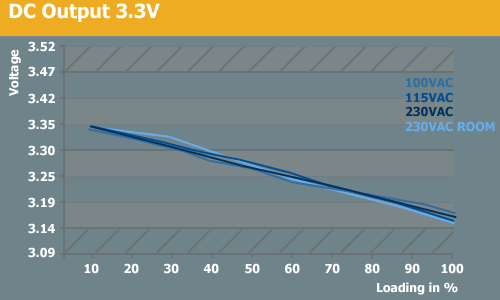
The 3.3V rail is the worst performing rail on the G1 power supply. It has a steadily decreasing voltage drop but does stay within specifications fortunately. Before sending us the samples the marketing people at Zippy expressed a little concern about the high temperature test environment, since their PSUs are rated at only 40°C. (We have to add here that most companies are rating their power supplies at just 25°C, so Zippy shouldn't have been concerned at all.) Temperatures didn't actually affect the results much, however, as even at room temperature we see similar performance from the various rails.
5V DC Output
| 5V Rail | |||
| Percentage | Ampere | Wattage | Wattage (All Rails) |
| 10% | 1.86 | 9.3 | 60.19 |
| 20% | 3.72 | 18.56 | 120.16 |
| 30% | 5.59 | 27.78 | 179.95 |
| 40% | 7.45 | 36.95 | 239.54 |
| 50% | 9.31 | 45.99 | 298.95 |
| 60% | 11.17 | 55.07 | 358.06 |
| 70% | 13.03 | 64.11 | 417.19 |
| 80% | 14.9 | 72.86 | 475.44 |
| 90% | 16.76 | 81.79 | 533.52 |
| 100% | 18.62 | 90.49 | 591.82 |
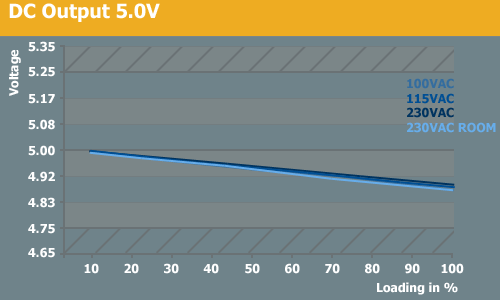
The 5V rail looks better and maintains a relatively steady output. With a range of 5.00V to 4.88V the 5V rail can be described as very stable. We might like to see the voltages shifted up 0.05V, but it's not really necessary.
12V DC Output
| 12V Rail | |||
| Percentage | Ampere | Wattage | Wattage (All Rails) |
| 10% | 3.64 | 43.75 | 60.19 |
| 20% | 7.27 | 87.24 | 120.16 |
| 30% | 10.91 | 130.81 | 179.95 |
| 40% | 14.55 | 174.31 | 239.54 |
| 50% | 18.18 | 217.62 | 298.95 |
| 60% | 21.82 | 260.75 | 358.06 |
| 70% | 25.45 | 303.87 | 417.19 |
| 80% | 29.09 | 346.75 | 475.44 |
| 90% | 32.73 | 389.16 | 533.52 |
| 100% | 36.36 | 431.96 | 591.82 |
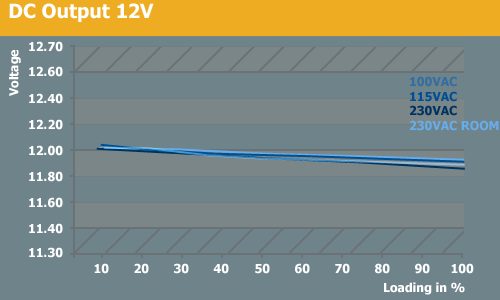
We weren't surprised to see the most stable 12V rails of any PSU we've tested so far - a clear indication of Zippy's server PSU roots. It doesn't matter what temperature, input voltage, or load use with this power supply; it gets to work and always delivers an extremely stable 12V output. The lowest output we measured was just 11.83V at 50°C and maximum load. We have not seen better results so far.
5Vsb DC Output
| 5Vsb Rail | |||
| Percentage | Ampere | Wattage | Wattage (All Rails) |
| 10% | 0.18 | 0.92 | 60.19 |
| 20% | 0.36 | 1.84 | 120.16 |
| 30% | 0.55 | 2.81 | 179.95 |
| 40% | 0.73 | 3.71 | 239.54 |
| 50% | 0.91 | 4.61 | 298.95 |
| 60% | 1.09 | 5.49 | 358.06 |
| 70% | 1.27 | 6.38 | 417.19 |
| 80% | 1.45 | 7.25 | 475.44 |
| 90% | 1.64 | 8.17 | 533.52 |
| 100% | 1.82 | 9.01 | 591.82 |
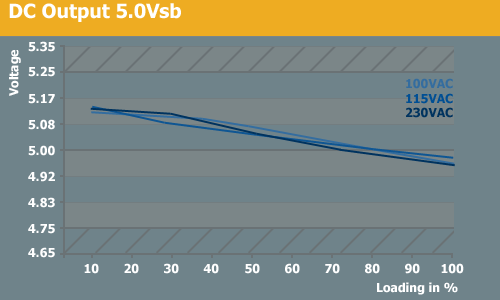
The 5Vsb rail has good results over the range of loads. It starts out somewhat high (which is usually considered better than being low) and at the highest load we had just a few millivolts less than the ideal.
Standby Efficiency
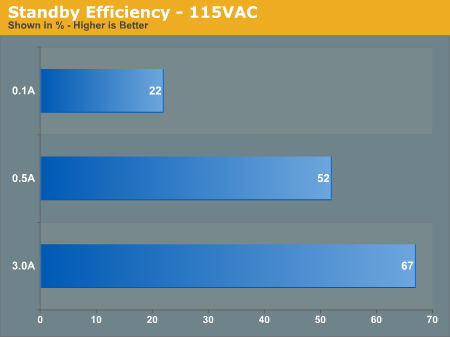
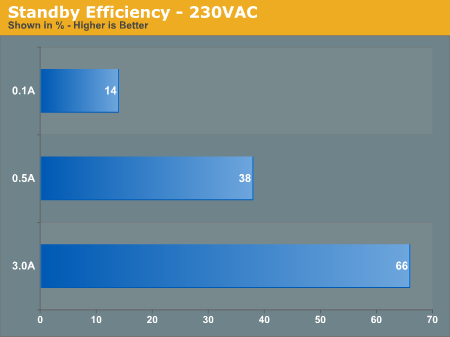
We do see minor flaws on the Zippy in terms of standby efficiency. With no load on any rail but 5Vsb we measured a power usage of 1.79W with 115VAC and a total of 3.5W at 230VAC. These amounts are quite high and this is an area that could definitely use more attention in the future. The standby efficiency itself could also use work; at just 14%-22% efficiency at low loads it is a very bad result indeed. If you leave your system on all the time, of course, this may not be much of a concern.
Efficiency
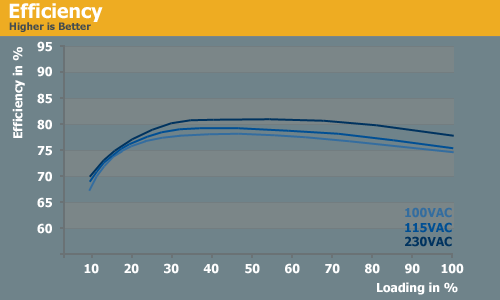
The overall efficiency is quite average and doesn't reach the level of any of our formerly tested units other than the Enermax Liberty, which it matches. This might come from the fact that for servers, high efficiency is often a secondary concern next to reliability. As we have seen already the standby efficiency is low (servers are almost never shut off) so we are not surprised to see these average results in overall efficiency.
PFC
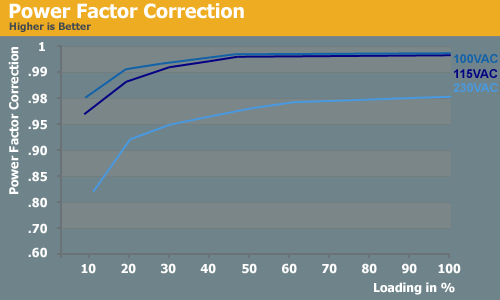
The power factor correction with lower input voltages is very good. We have seen a big difference between the 100-115VAC and 230VAC with all of the power supplies so far, and PFC could certainly be improved with higher input voltages.
Fan Speed, Acoustics, and Temperatures
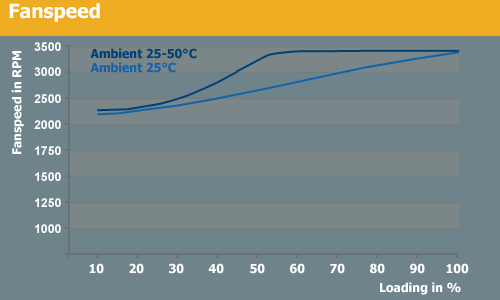
There are flaws visible with the 80mm fan design. As we have seen previously with the PC Power & Cooling Silencer, 80mm fans can often be quite loud even at lower loads. If the load increases the 80mm fans can kick into "hair-dryer mode", and while that may not be a major problem in a data center that's not generally something most people want sitting under their desk. Zippy appears to have taken their fan speed approach from their server designs, and it spins faster and increases RPMs much earlier than what we see in many other consumer PSUs. However, as we'll see on the temperature graphs, it is clearly necessary for them to increase fan speed as the temperature is rising steadily.
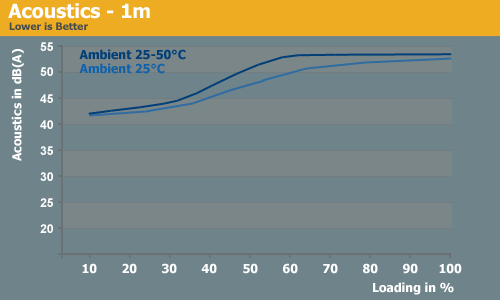
The fan starts at 2250 RPM which is already fast and loud. At 42dB(A) this power supply is far from being quiet and can easily be heard whenever it's in use. At 50% load under higher temperatures the fan is already at its maximum speed: around 3400 RPM and a noise from 54dB(A). Unfortunately, at lower room temperatures the noise levels aren't any better than at higher temperatures.
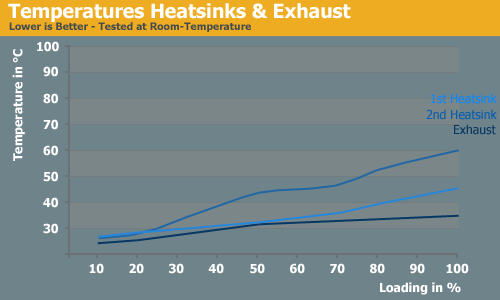
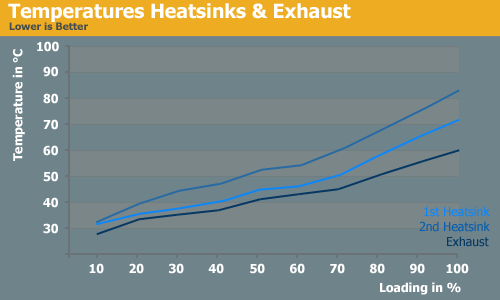
The heatsinks reach up to 60°C in a normal room temperature environment, and up to 83°C while running at 50°C ambient temperature. The design dissipates heat quite well but it's not good enough as temperatures increase steadily even with the high fan RPMs. It appears that the shape and size of the heatsinks is not sufficient to keep temperatures down, and the little noisy fan can't quite keep up.
Conclusion
With the results we've just presented, it's pretty easy to come to a conclusion. Zippy's origins of being a server and redundant power supply maker are clear in many aspects of the G1. Everything is built to survive even in difficult operating environments, but it needs to be cooled efficiently. To help cool it down, you need a lot of airflow, and if with an 80mm fan that means high RPMs to suck the air through the PSU as fast as possible. Many rack servers are built in this fashion, with numerous small, high-RPM fans. Needless to say, such servers are anything but quiet.
So what sort of people would buy this kind of power supply? It will surely not be the silence enthusiasts or those looking to build a decent HTPC, and neither will it be somebody building a PC for the living room that will run 24/7. Those who would be willing to buy this power supply and stomach the high buying price will need to be real performance enthusiasts that don't care about noise. If you want a stable and reliable power supply that will perform well under just about any circumstances, the Zippy G1 is worth a look. In most other areas, it unfortunately falls short.
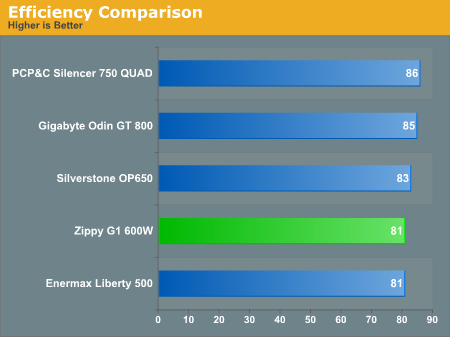
From the efficiency point of view, we the results aren't spectacular. With just 81% efficiency using 230VAC, the Zippy doesn't break any new ground in the high-end PSU market. The standby efficiency was quite low as well, generating results as low as 14% (albeit at loads that make such a result less critical).
Zippy is producing all of their power supplies in Taiwan, and this is clearly visible in the build quality. The 12V rail is the most stable we have seen so far. We would have liked to see more PEG connectors instead of only two 6-pin connections, particularly for a "gaming" PSU, but for upper midrange or lower high-end configurations this should still be sufficient. With this 600W power supply you can definitely run higher-end systems, but you might want to look elsewhere if you're interested in quad core processors, overclocking, and dual high-end GPUs. (Ed: as in, all three at the same time - such configurations can pull over 750W at load!). If you're looking at running a setup with a lot of hard drives, however, you do get plenty of peripheral connectors, and lengths of up to 75cm are sufficient for use with most tower cases.
Availability in the market is not where we'd like it to be, and we hoped to see this PSU at more resellers by now. Unfortunately, we have been unable to find any major shops that stock this power supply at present. A quick search with Google did result in a couple hits, but with prices starting at $170 we have to say that there are certainly better options. The Zippy G1/GSM-6600P certainly performs well and we can recommend it to people looking to build a high-end system who don't care about the noise levels and the lack of PEG connectors. We're not sure many individuals actually fall into that category, however, and there are definitely other vendors with similar or better products.
With their gaming series Zippy has made a first attempt at catering to the retail market and created a hybrid power supply that sits somewhere between gaming and server needs. It ends up not quite satisfying either market, and it needs a lot of tweaking before it can become a true gaming power supply that we can fully recommend.







